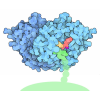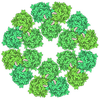[English] 日本語
 Yorodumi
Yorodumi- PDB-7ml7: Structural basis for CSPG4 as a receptor for TcdB and a therapeut... -
+ Open data
Open data
- Basic information
Basic information
| Entry | Database: PDB / ID: 7ml7 | ||||||
|---|---|---|---|---|---|---|---|
| Title | Structural basis for CSPG4 as a receptor for TcdB and a therapeutic target in Clostridioides difficile infection | ||||||
 Components Components |
| ||||||
 Keywords Keywords | TOXIN / CSPG4 / TcdB / Clostridioides difficile infection | ||||||
| Function / homology |  Function and homology information Function and homology informationCS-GAG biosynthesis / Defective CHST3 causes SEDCJD / Defective CHST14 causes EDS, musculocontractural type / Defective CHSY1 causes TPBS / DS-GAG biosynthesis / Defective B3GALT6 causes EDSP2 and SEMDJL1 / CS/DS degradation / Defective B4GALT7 causes EDS, progeroid type / Defective B3GAT3 causes JDSSDHD / substrate-dependent cell migration ...CS-GAG biosynthesis / Defective CHST3 causes SEDCJD / Defective CHST14 causes EDS, musculocontractural type / Defective CHSY1 causes TPBS / DS-GAG biosynthesis / Defective B3GALT6 causes EDSP2 and SEMDJL1 / CS/DS degradation / Defective B4GALT7 causes EDS, progeroid type / Defective B3GAT3 causes JDSSDHD / substrate-dependent cell migration / Glycosaminoglycan-protein linkage region biosynthesis / glial cell migration / tissue remodeling / ruffle assembly / glucosyltransferase activity / Differentiation of Keratinocytes in Interfollicular Epidermis in Mammalian Skin / host cell cytosol / positive regulation of peptidyl-tyrosine phosphorylation / Transferases; Glycosyltransferases; Hexosyltransferases / lamellipodium membrane / platelet-derived growth factor receptor signaling pathway / coreceptor activity / ruffle / cysteine-type peptidase activity / lysosomal lumen / host cell endosome membrane / Golgi lumen / toxin activity / : / angiogenesis / Hydrolases; Acting on peptide bonds (peptidases); Cysteine endopeptidases / positive regulation of MAPK cascade / intracellular signal transduction / apical plasma membrane / focal adhesion / lipid binding / protein kinase binding / host cell plasma membrane / cell surface / proteolysis / extracellular exosome / extracellular region / nucleoplasm / metal ion binding / membrane / plasma membrane Similarity search - Function | ||||||
| Biological species |  Clostridioides difficile (bacteria) Clostridioides difficile (bacteria) Homo sapiens (human) Homo sapiens (human) | ||||||
| Method | ELECTRON MICROSCOPY / single particle reconstruction / cryo EM / Resolution: 3.17 Å | ||||||
 Authors Authors | Chen, P. / Jin, R. | ||||||
| Funding support |  United States, 1items United States, 1items
| ||||||
 Citation Citation |  Journal: Nat Commun / Year: 2021 Journal: Nat Commun / Year: 2021Title: Structural basis for CSPG4 as a receptor for TcdB and a therapeutic target in Clostridioides difficile infection. Authors: Peng Chen / Ji Zeng / Zheng Liu / Hatim Thaker / Siyu Wang / Songhai Tian / Jie Zhang / Liang Tao / Craig B Gutierrez / Li Xing / Ralf Gerhard / Lan Huang / Min Dong / Rongsheng Jin /    Abstract: C. difficile is a major cause of antibiotic-associated gastrointestinal infections. Two C. difficile exotoxins (TcdA and TcdB) are major virulence factors associated with these infections, and ...C. difficile is a major cause of antibiotic-associated gastrointestinal infections. Two C. difficile exotoxins (TcdA and TcdB) are major virulence factors associated with these infections, and chondroitin sulfate proteoglycan 4 (CSPG4) is a potential receptor for TcdB, but its pathophysiological relevance and the molecular details that govern recognition remain unknown. Here, we determine the cryo-EM structure of a TcdB-CSPG4 complex, revealing a unique binding site spatially composed of multiple discontinuous regions across TcdB. Mutations that selectively disrupt CSPG4 binding reduce TcdB toxicity in mice, while CSPG4-knockout mice show reduced damage to colonic tissues during C. difficile infections. We further show that bezlotoxumab, the only FDA approved anti-TcdB antibody, blocks CSPG4 binding via an allosteric mechanism, but it displays low neutralizing potency on many TcdB variants from epidemic hypervirulent strains due to sequence variations in its epitopes. In contrast, a CSPG4-mimicking decoy neutralizes major TcdB variants, suggesting a strategy to develop broad-spectrum therapeutics against TcdB. | ||||||
| History |
|
- Structure visualization
Structure visualization
| Movie |
 Movie viewer Movie viewer |
|---|---|
| Structure viewer | Molecule:  Molmil Molmil Jmol/JSmol Jmol/JSmol |
- Downloads & links
Downloads & links
- Download
Download
| PDBx/mmCIF format |  7ml7.cif.gz 7ml7.cif.gz | 287.7 KB | Display |  PDBx/mmCIF format PDBx/mmCIF format |
|---|---|---|---|---|
| PDB format |  pdb7ml7.ent.gz pdb7ml7.ent.gz | 205.8 KB | Display |  PDB format PDB format |
| PDBx/mmJSON format |  7ml7.json.gz 7ml7.json.gz | Tree view |  PDBx/mmJSON format PDBx/mmJSON format | |
| Others |  Other downloads Other downloads |
-Validation report
| Arichive directory |  https://data.pdbj.org/pub/pdb/validation_reports/ml/7ml7 https://data.pdbj.org/pub/pdb/validation_reports/ml/7ml7 ftp://data.pdbj.org/pub/pdb/validation_reports/ml/7ml7 ftp://data.pdbj.org/pub/pdb/validation_reports/ml/7ml7 | HTTPS FTP |
|---|
-Related structure data
| Related structure data |  23909MC M: map data used to model this data C: citing same article ( |
|---|---|
| Similar structure data |
- Links
Links
- Assembly
Assembly
| Deposited unit | 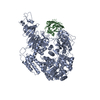
|
|---|---|
| 1 |
|
- Components
Components
| #1: Protein | Mass: 228752.531 Da / Num. of mol.: 1 Source method: isolated from a genetically manipulated source Source: (gene. exp.)  Clostridioides difficile (bacteria) / Gene: tcdB, toxB / Production host: Clostridioides difficile (bacteria) / Gene: tcdB, toxB / Production host:  References: UniProt: P18177, Hydrolases; Acting on peptide bonds (peptidases); Cysteine endopeptidases |
|---|---|
| #2: Protein | Mass: 82298.305 Da / Num. of mol.: 1 Source method: isolated from a genetically manipulated source Source: (gene. exp.)  Homo sapiens (human) / Gene: CSPG4, MCSP Homo sapiens (human) / Gene: CSPG4, MCSPProduction host: Mammalian expression vector BsrGI-MCS-pcDNA3.1 (others) References: UniProt: Q6UVK1 |
| #3: Chemical | ChemComp-ZN / |
| Has ligand of interest | N |
| Has protein modification | Y |
-Experimental details
-Experiment
| Experiment | Method: ELECTRON MICROSCOPY |
|---|---|
| EM experiment | Aggregation state: PARTICLE / 3D reconstruction method: single particle reconstruction |
- Sample preparation
Sample preparation
| Component |
| ||||||||||||||||||||||||
|---|---|---|---|---|---|---|---|---|---|---|---|---|---|---|---|---|---|---|---|---|---|---|---|---|---|
| Source (natural) |
| ||||||||||||||||||||||||
| Source (recombinant) |
| ||||||||||||||||||||||||
| Buffer solution | pH: 7.5 | ||||||||||||||||||||||||
| Specimen | Embedding applied: NO / Shadowing applied: NO / Staining applied: NO / Vitrification applied: YES | ||||||||||||||||||||||||
| Vitrification | Cryogen name: ETHANE |
- Electron microscopy imaging
Electron microscopy imaging
| Experimental equipment |  Model: Titan Krios / Image courtesy: FEI Company |
|---|---|
| Microscopy | Model: FEI TITAN KRIOS |
| Electron gun | Electron source:  FIELD EMISSION GUN / Accelerating voltage: 300 kV / Illumination mode: FLOOD BEAM FIELD EMISSION GUN / Accelerating voltage: 300 kV / Illumination mode: FLOOD BEAM |
| Electron lens | Mode: BRIGHT FIELD |
| Image recording | Electron dose: 46 e/Å2 / Film or detector model: GATAN K3 (6k x 4k) |
- Processing
Processing
| Software |
| ||||||||||||||||||||||||
|---|---|---|---|---|---|---|---|---|---|---|---|---|---|---|---|---|---|---|---|---|---|---|---|---|---|
| CTF correction | Type: PHASE FLIPPING AND AMPLITUDE CORRECTION | ||||||||||||||||||||||||
| Symmetry | Point symmetry: C1 (asymmetric) | ||||||||||||||||||||||||
| 3D reconstruction | Resolution: 3.17 Å / Resolution method: FSC 0.143 CUT-OFF / Num. of particles: 177995 / Symmetry type: POINT | ||||||||||||||||||||||||
| Refinement | Cross valid method: NONE Stereochemistry target values: GeoStd + Monomer Library + CDL v1.2 | ||||||||||||||||||||||||
| Displacement parameters | Biso mean: 63.27 Å2 | ||||||||||||||||||||||||
| Refine LS restraints |
|
 Movie
Movie Controller
Controller




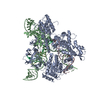


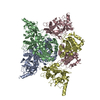


 PDBj
PDBj

